By historic standards, I’m carrying a light pack. Each voyageur normally carried two 90-pound bundles up this trail. Some showoffs would carry a bundle or two more. I’m carrying only enough weight for an overnight trip in northern Minnesota in October – a tent and sleeping bag, warm clothes, and a few meals.
I’m hiking the Grand Portage, the trail that gave the historic trading post its purpose and the national monument its name. Grand Portage is also the English-language name of the Anishinaabe community here, the Grand Portage Band of Chippewa Indians. You may know the Anishinaabeg as the Ojibwe; in accordance with the Band’s wishes, the National Park Service generally uses the name “Ojibwe” today except in legal documents.

The Grand Portage trail goes through a pass in Minnesota's Sawtooth Mountains. They are lovely, but you won't mistake them for the Rockies.
The Grand Portage, Gichi Onigamiing, avoids the falls of the Pigeon River. It travels over a pass from Gichi-gami (Lake Superior) to the fur-rich country beyond. Today the trail provides an unusual example of a historic trail that you can hike in its entirety, much as the Ojibwe and the voyageurs experienced it.
You could start at about the midpoint of the portage by parking off Old Highway 61, making half of the trail into a reasonable day hike. However, I’d rather experience the entire length of the portage in a day, as the voyageurs did. To do this, I’m spending a night at Fort Charlotte on the Pigeon River.
Backpackers need a permit from the Heritage Center, so that’s where I start.

You pick up backpacking permits at the national monument's visitor center/Robert Pahre
The center welcomes you with museum-type exhibits, interpreters in modern uniform or historic costume, a nice bookstore, and some other spaces. Building this year-round Heritage Center was the centerpiece of the monument’s 2003 General Management Plan, giving visitors a warm destination for the five months of a northern Minnesota winter. The Heritage Center also fulfilled a promise made more than four decades ago to the Grand Portage Band.
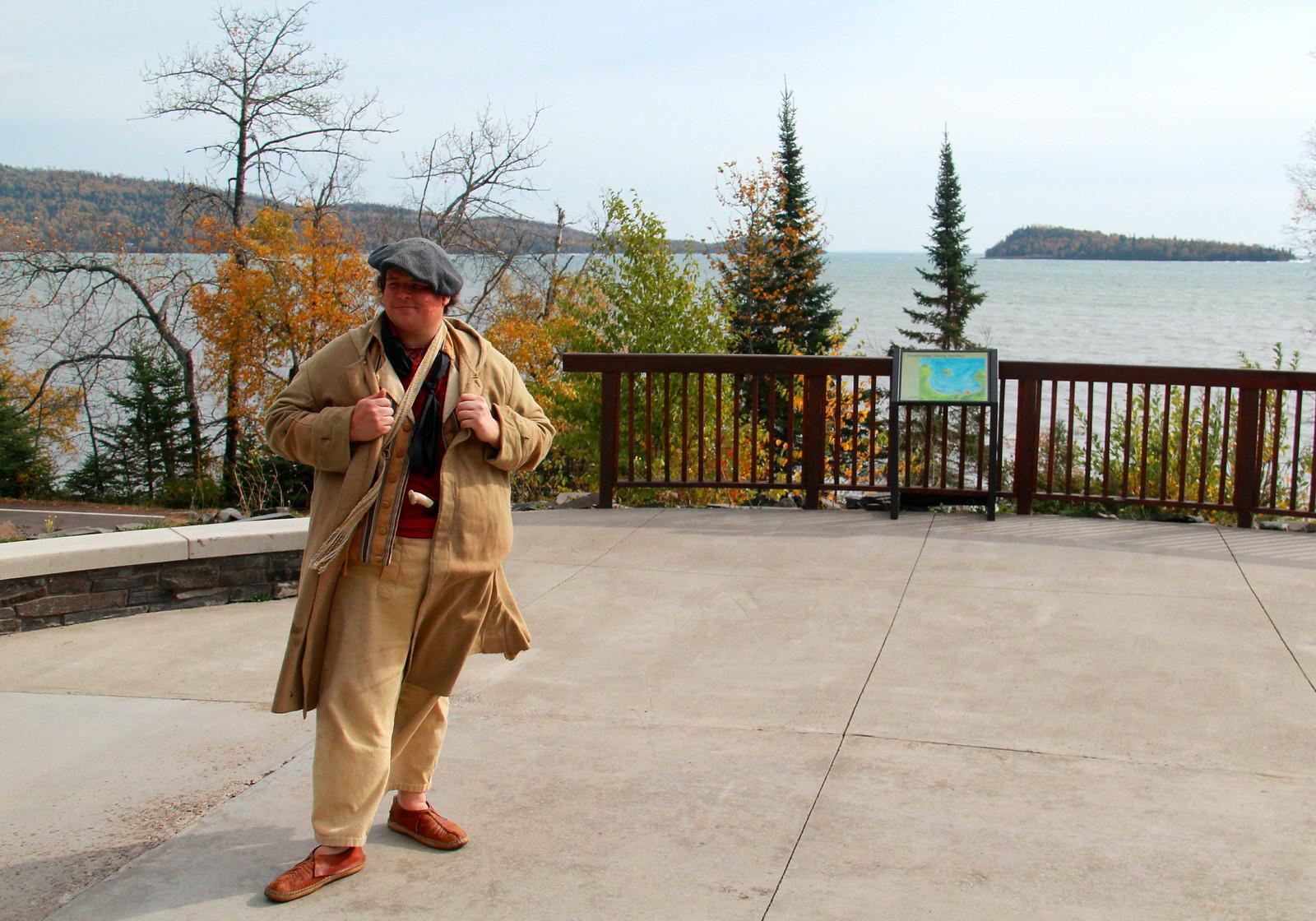
At the visitor center re-enactors try to convey the life of voyageurs and those who worked at the trading post/Robert Pahre
The monument's management plan has brought many changes since my first visit to Grand Portage, making the visitor experience much better. There’s an improved historic landscape and expanded interpretation in and around the reconstructed stockade. Another improvement, a paved walkway from the Heritage Center to the stockade, provided the start of my hike. In park planning terms, it takes me from the Visitor Services and Development Zone into the Interpretive Historic Zone.
This new approach path provides some visual separation between the historical site and the parking lot, so that visitors don’t park within view of the stockade. This helps orient you away from modern life and toward the fur trade period. Such changes make Grand Portage a good place to reflect on how the national parks manage their resources and interpret their meanings to visitors.

The trading post at Grand Portage National Monument/Robert Pahre
As I walked down the path, the stockade soon came into view. The sharpened logs that make up the stockade wall present the classic view of an “Indian fort” for many Americans. Of course, this is a trading post and not a fort, but the North West Company thought the fence prudent.
Not surprisingly, the logs are not original. Neither is anything else. The entire stockade area consists of reconstructed historic buildings, relying on evidence from archaeology and written documents. Oral histories of the Grand Portage Band have not played an important role in the stockade, though they appear in the Heritage Center exhibits.
Visitors tend to enjoy these kinds of reconstructed buildings, which give them a sense of what a site looked like. In contrast, NPS policy has turned against reconstructions because they are not authentic survivals from the past. As a result, they inevitably reflect current interpretations of history and the limits of our evidence. Indeed, some parks have built notoriously inaccurate reconstructions and some have put buildings in the wrong place. Historic structures are expensive to research, build, and maintain. Moreover, truly accurate reconstructions wouldn’t have wheelchair-accessible ramps, smoke detectors, or other regulatory requirements. New buildings also have significant impacts on the cultural landscape—they can destroy many layers of history while reconstructing just one.
Despite this, reconstructed buildings will remain a part of Grand Portage National Monument. The reconstructions predate the national monument, and Congress defined those buildings as part of the site’s “unique historical values.” The Grand Portage Band donated lands to the monument with the understanding that the NPS would build new reconstructions as well as a visitor center. The Band believes these will attract more tourists, and I am sure they are right about that.

The trading post at the national monument, with its fence stockade, overlooking Grand Portage Bay/Robert Pahre
The Band also wanted the national monument to tell visitors more about Ojibwe heritage. The original plan called for an Ojibwe Heritage demonstration area in an out-of-the-way location that many visitors would tend not to see after visiting the stockade. The monument now has an area displaying an Ojibwe garden, wigiiwaam (wigwam), and birch bark processing area.
This heritage area does not go as far as the Band would like. Former Chairman Norman Deschamps pointed out that the Ojibwe assisted the North West Company in many ways, exchanging food and material objects for trade goods, and sharing their technology and geographical knowledge with the Europeans. The stockade includes a reconstructed Great Hall, kitchen, and canoe warehouse, among other buildings, but it does not show the fur store where they traded, nor where the Ojibwe translators lived. On behalf of his people, Chairman Deschamps called for reconstructions that would make the Ojibwe role in history more visible.

A classic domed wigiiwaam (wigwam) made of birch bark. Grand Portage National Monument, on the lands of the Grand Portage Band of Chippewa Indians - now known as the Anishinaabe or Ojibwe.
Because the monument lies inside an Indian reservation, the relationship between the NPS and the Grand Portage plays an important role in shaping the landscape that visitors see. Like all relationships, it has its successes and failures. The national monument hasn’t always seen the Band as a sovereign government as opposed to just another stakeholder – like the Minnesota Historical Society, say.
With some of those criticisms in mind, I explored the Ojibwe heritage area and the inside of the stockade. I had the site to myself for a little while before a guided tour came along. I slipped into the group to hear the guide give a talk inside the canoe house. The monument has an impressive collection of canoes, made by local master craftsmen, as well as tools and some raw materials at various stages of being worked. The guide explained how native peoples made these canoes and kept them in good repair.
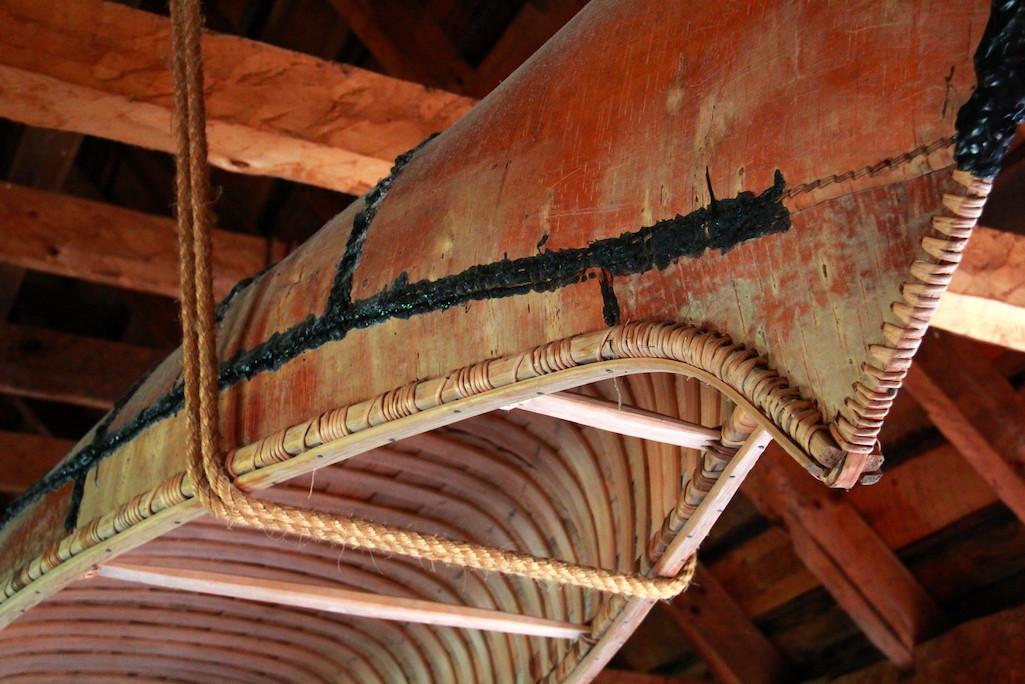
The biggest canoe of the fur trade was the canot du maître or Montreal canoe. They could be 40 feet (12 meters) long, with a capacity of 4 tons/Robert Pahre
After the talk, I found my way out the stockade’s other gate and onto the Grand Portage itself. In planning speak, I was leaving the Interpretive Historic Zone and entering the Primitive Trail Zone. This zone consists of “a rugged trail through a natural-appearing forest corridor” according to the management plan. An interpretive sign describing the trail provided the park’s last interpretation for almost nine miles.
The national monument wants the trail to suggest the historic landscape of the original portage, making visitors feel as if they had traveled back to the 1700s. As it turns out, the landscape is considerably different today. The Grand Portage goes through a second-growth forest and not the primeval forest of the fur trade era. That’s historically inaccurate, but there’s not much anyone can do to hurry a forest along.

You can hike the route of the old portage and camp at the Fort Charlotte site. The trail is muddy in three seasons, frozen in the fourth/Robert Pahre
The historic landscape along the trail makes up the Resources Trust Zone. In addition to keeping modernity at bay, this zone provides an “archaeological data bank.” The monument manages the Resources Trust Zone to preserve unexcavated ecological resources, protect wetlands, and provide some habitat for plants and animals. Visitors could enter the zone if they like, but there is little reason to leave the trail.
Outside the narrow corridor, these lands belong to the Grand Portage Band of Chippewa Indians. The Band has every right to harvest trees commercially on its own lands, even if this would damage the views from the trail. Because of their long-standing partnership with the NPS, the Band has chosen to be sensitive to the monument’s concerns about the historic viewscape. In winter I would not be surprised to hear snowmobiles in the distance, but in October the soundscape remains natural.
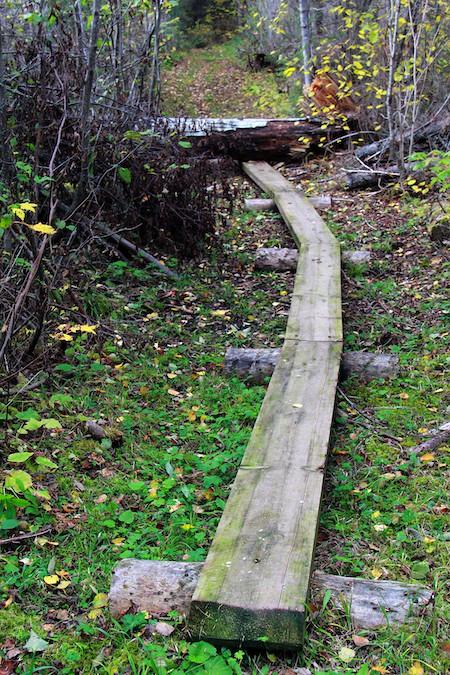
The nine-mile Grand Portage Trail follows the original voyageur portage route/Robert Pahre
As I continued up the trail, I found it difficult to establish any steady pace. The irregular pattern of dry patches, wet patches, mud, and planks meant that I kept changing my stride. This made the trail more tiring than I would have expected from the moderate length and modest elevation gain. The many planks across muddy parts seemed modern, but it turns out that footboards were also part of the historic portage.
The trail crosses two highways, but I did not see or hear a vehicle on either one. Other than that, the largest human impact came in the form of a long boardwalk across a beaver pond, a few feet above the water. Having had some experience crossing beaver dams, I would say that this “visual intrusion” was almost essential for anyone to use the trail at all.
Not long after the boardwalk, I arrived at the Fort Charlotte area. None of the historic fort remains visible, and its exact site is unmarked. The historic fort provided the base for travel into the interior beyond the portage. Today it sees some canoe traffic in the other direction as paddlers can come here out of the Boundary Waters wilderness. The rudimentary dock provides a take-out location on the Pigeon River that separates the U.S. and Canada here.
The monument classifies the Fort Charlotte area as a “recreation zone,” so I had left the “primitive trail zone.” In addition to the dock, Fort Charlotte has several interpretive signs, tent platforms, picnic tables, and an outhouse. I appreciated them all, though I was surprised to see tent platforms. Finding a way to stake my tent to a wooden platform posed a minor challenge that I managed to solve well enough.
The NPS knows that some visitors would like to visit Fort Charlotte but are physically unable to hike or canoe here. Despite this, the monument has chosen not to provide vehicle access here. A road and parking lot would require costly construction on lands that the Band owns, using funds the monument does not have. Once built, the NPS would also have to staff the site seasonally, and would need to increase its ranger presence to prevent damage to archaeological resources.
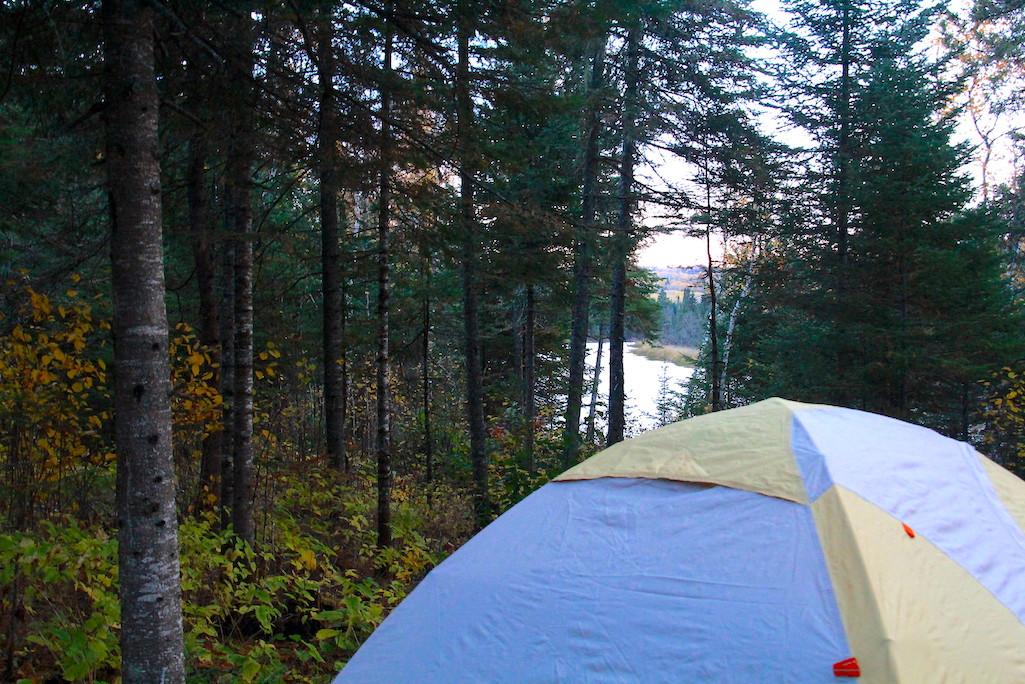
The author's campsite at Fort Charlotte/Robert Pahre
Vehicles and parking, even if shielded from view, would also destroy the historic feel of the site and the opportunity for a more primitive recreational experience. The monument would prefer to put reconstruction budgets and energies into the stockade areas for all visitors to enjoy.
I finished my camp chores and took some photographs as river reflected colors of the sunset. As I fell asleep, I heard two fairly large animals run through my camp. That provided a welcome reminder that the natural world provides an important part of the human landscape at Grand Portage and many other historic sites. I slept well and then hiked back to Gichi-gami the next morning.
Robert Pahre is a professor of political science at the University of Illinois who teaches and writes on the politics of national parks. You can find more photos of Grand Portage in his Flickr album.
Additional resources on Grand Portage National Monument can be found in these past stories:
Traveler's Checklist: Grand Portage National Monument
Isle Royale National Park Delivers Handwoven Mats To Grand Portage National Monument
Paddling The Border Route In The Boundary Waters
National Parks Traveler Episode 53: Special Report On The Colorado River, Grand Portage NM

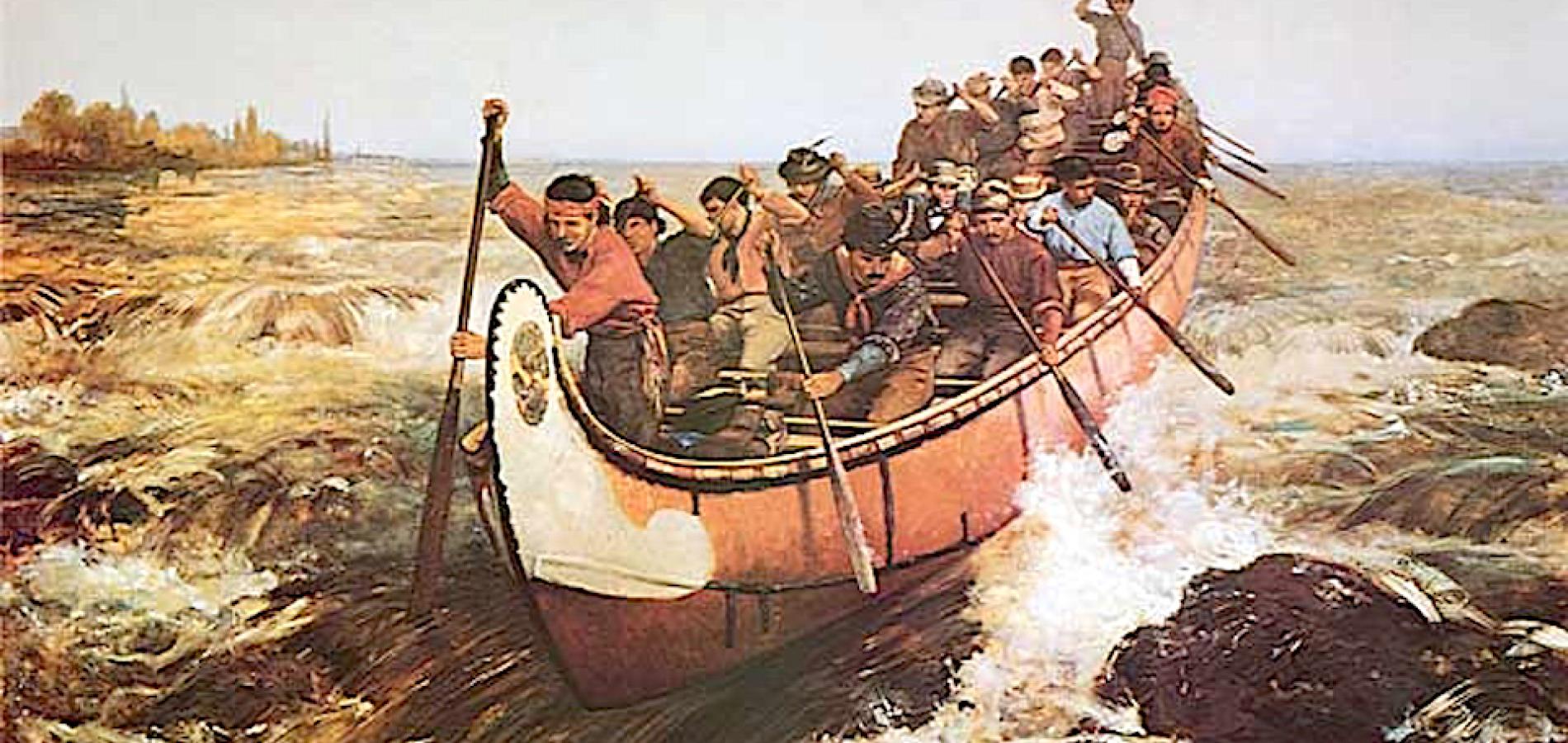
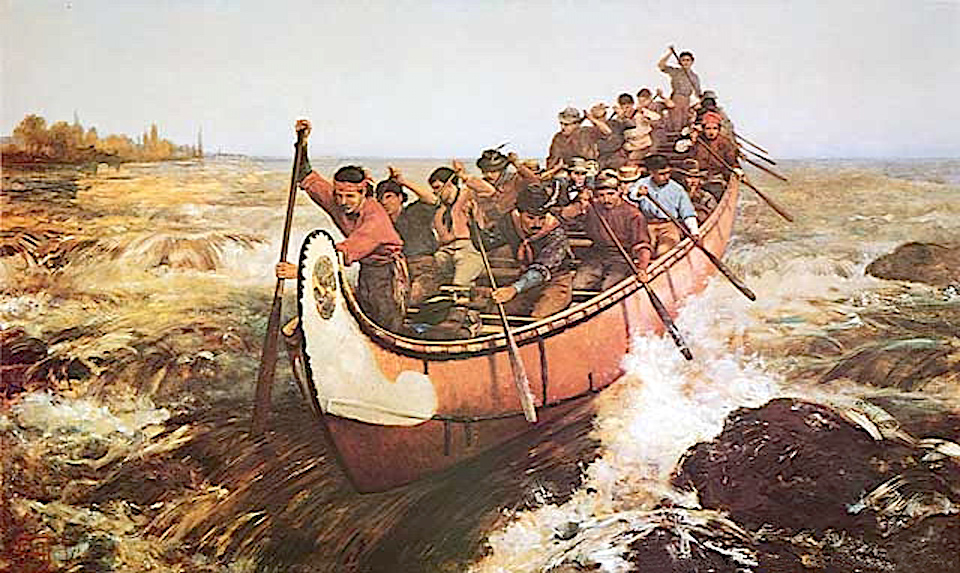

 Support Essential Coverage of Essential Places
Support Essential Coverage of Essential Places







Add comment